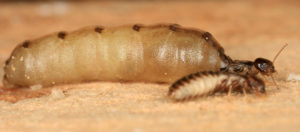Texas A&M scientist is among team to prove royalty among termites
Discovery could lead to eco-friendly control measures
Writer: Steve Byrns, 325-653-4576, [email protected]
Contact: Dr. Ed Vargo, 979-845-5855, [email protected]
COLLEGE STATION – Termites! Just the insects’ common name can strike fear in the hearts of most any homeowner, but a recently published work could go a long way in quelling some of those fears, said one of the authors.
Dr. Ed Vargo, Endowed Chair in Urban and Structural Entomology at Texas A&M University, College Station, is among a team of scientists who recently published “Identification of a Queen and King Recognition Pheromone in the Subterranean Termite Reticulitermes,” in the scientific journal Proceedings of the National Academy of Sciences http://www.pnas.org/content/early/2018/03/15/1721419115
Co-authors with Vargo were Dr. Coby Schal, Blanton J. Whitmire Distinguished Professor of Entomology, North Carolina State University, Raleigh, North Carolina; Colin Funaro, doctoral student for Vargo and Schal, North Carolina State University; and Dr. Katalin Boroczky, research chemist, Penn State University, State College, Pennsylvania.

Termites are group of wood-eating insects that serve as important decomposers in nature, but some types are highly destructive pests to human-built structures, Vargo said.
“Regardless of type, all termites live in highly cooperative colonies consisting of different castes, such as the kings and queens, the reproductive caste and the worker or non-reproductive caste,” Vargo said. “It’s long been suspected that termites within a colony can distinguish caste members based on chemical cues, but until now no active chemical compounds had been identified. Our team of biologists and chemists set out to identify those chemical cues that mediate caste recognition.”
To find those chemical cues, called pheromones, the team selected Reticulitermes flavipes, the most widespread North American termite species, to study. They isolated a hydrocarbon, heneicosane, a substance unique to royals, applied it to glass “dummy queens” and were able to duplicate the same behavior in workers to the glass queens as they exhibit to real termite royals.
Vargo said the work represents an important breakthrough, especially when one considers social insects such as honeybees, fire ants and termites are remarkable creatures among which thousands of individuals work together to form a superorganism.
“How these superorganisms function and how they evolved have long been of intense interest to scientists,” he said. “This work helps us understand how termites and other social insect colonies function and offers a window into their evolution.
“Because termites rely heavily on chemical communication to function efficiently, by decoding their chemical language, in the future we may be able to disrupt their activity in a targeted and environmentally friendly way to protect our homes and property.”


